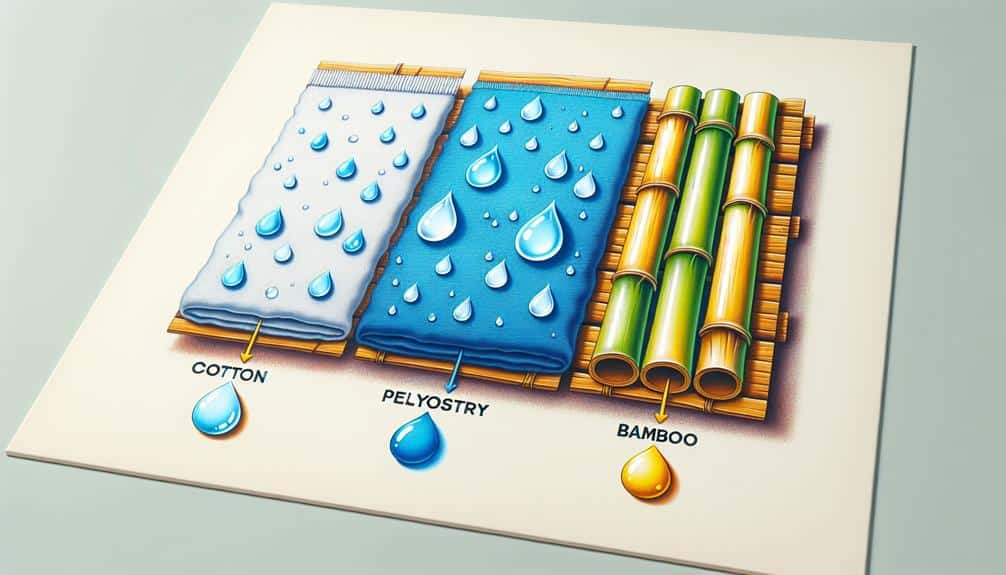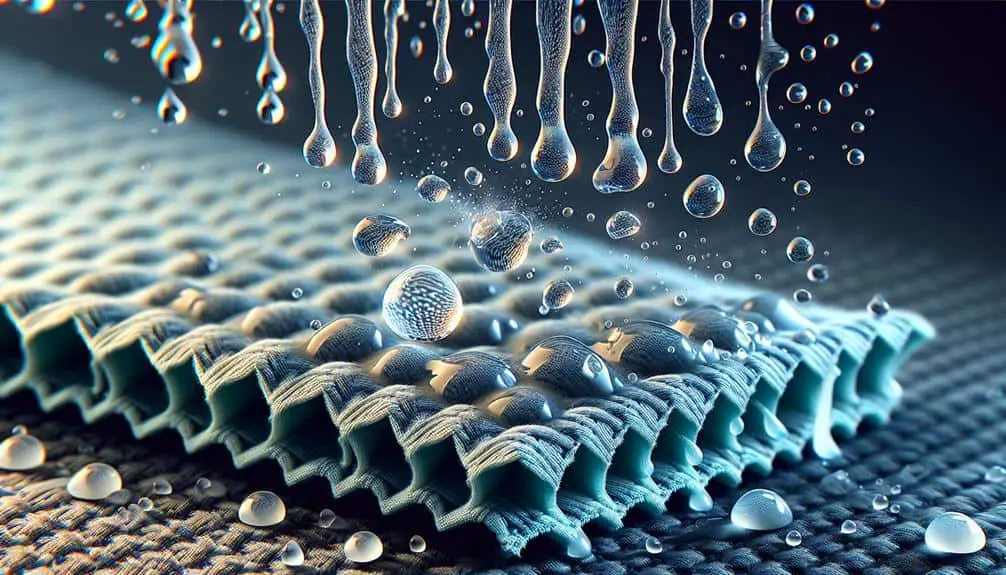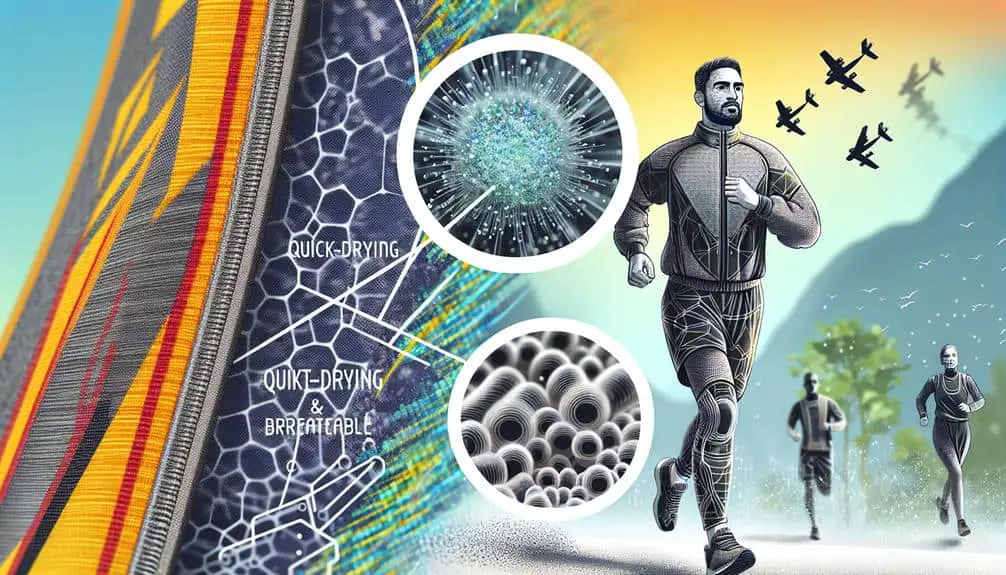In hot weather, polyester excels at wicking moisture, thanks to its hydrophobic fibers that repel water. The fabric guarantees quick drying, breathability, and durability, making it a top choice for active individuals. Nylon also swiftly draws sweat away, keeping you dry and comfortable during activities. Merino wool stands out for its ability to absorb and release moisture, along with odor-resistant properties. Bamboo offers remarkable moisture-wicking abilities and improved airflow. Polypropylene, with outstanding capabilities, facilitates quick evaporation and comfort. Each type has unique features for best performance in warm conditions.
Key Points
- Polyester: Ideal for moisture-wicking, quick drying, and breathable comfort in hot weather.
- Nylon: Swiftly draws sweat away, lightweight, and dries quickly for comfort during activities.
- Merino Wool: Absorbs sweat, releases moisture, and is odor-resistant for prolonged wear.
- Bamboo: Remarkable moisture-wicking, breathability, and odor prevention in hot conditions.
- Polypropylene: Outstanding moisture-wicking, quick evaporation, and durable for hot weather activities.
Polyester
When selecting the best fabric for moisture-wicking properties, polyester stands out as a top choice due to its excellent moisture management capabilities. Polyester fibers are hydrophobic, meaning they repel water and allow moisture to evaporate quickly. This characteristic not only provides breathable comfort but also guarantees quick drying performance, making polyester an ideal choice for activewear and outdoor gear in hot weather conditions.
Polyester fabric is engineered to have tiny gaps between the fibers, promoting airflow and enhancing breathability. This feature allows sweat to be pulled away from the skin to the outer surface of the fabric where it can evaporate more readily. Additionally, polyester is known for its durability, color retention, and resistance to shrinking and wrinkles, making it a reliable option for those seeking high-performance clothing.
Nylon
Nylon fabric's moisture-wicking properties make it a popular choice for activewear and outdoor gear, thanks to its ability to swiftly draw sweat away from the skin. Nylon benefits from being lightweight and durable, making it ideal for high-impact activities where durability is key. Its moisture-wicking capabilities guarantee that sweat is efficiently pulled away from your body, keeping you dry and comfortable during intense workouts or outdoor adventures. Additionally, nylon dries quickly, which is advantageous for those who need their clothing to dry fast between activities.
However, there are some drawbacks to nylon fabric. While it excels at moisture-wicking, it isn't as effective at odor control as some other fabrics, which may be a concern for individuals involved in prolonged physical activities. Additionally, nylon isn't as breathable as natural fibers like cotton or wool, which can lead to increased perspiration in hot and humid conditions. Despite these drawbacks, the moisture-wicking properties and durability of nylon make it a top choice for many athletes and outdoor enthusiasts.
Merino Wool
Merino wool's moisture-wicking capabilities and natural breathability make it a standout choice for activewear and outdoor gear, providing a comfortable and functional option for those seeking performance-enhancing properties.
As one of the finest natural fibers available, Merino wool excels in moisture management by absorbing sweat away from the body and releasing it into the air, keeping you dry and comfortable during physical activities. Its breathable nature allows for enhanced airflow, preventing overheating and ensuring you stay cool in hot weather.
Additionally, Merino wool is odor-resistant, making it ideal for prolonged wear without the worry of unpleasant smells. The unique structure of Merino wool fibers enables them to trap and neutralize odor-causing bacteria, maintaining freshness even after strenuous use.
When it comes to choosing high-performance fabrics, Merino wool stands out for its exceptional moisture-wicking, breathability, and odor-resistant properties, making it a top choice for those seeking superior comfort and functionality in their activewear.
Bamboo
Bamboo fabric demonstrates remarkable moisture-wicking properties, making it a popular choice for activewear and outdoor gear due to its capability to keep you dry and comfortable during physical activities. The advantages of bamboo fabric lie in its innate breathability and moisture-absorbing capabilities. Bamboo fibers have micro-gaps that assist in ventilation, allowing for improved airflow and moisture control. This not only helps in whisking away sweat from your body but also prevents the growth of odor-causing bacteria, keeping your clothing fresh during extended use.
When it comes to caring for bamboo fabric, it's vital to follow specific guidelines to maintain its performance and longevity. To safeguard the durability of your bamboo garments, it's recommended to wash them in cold water on a gentle cycle. Avoid using harsh detergents or fabric softeners as they can harm the fibers and diminish their moisture-wicking properties. Additionally, air-drying bamboo fabric is preferable to using a dryer, as excessive heat can degrade the fabric. By following these care instructions, you can maximize the benefits of bamboo fabric and enjoy its exceptional moisture-wicking abilities for an extended period.
Polypropylene
Polypropylene fabric demonstrates outstanding moisture-wicking capabilities, making it a preferred choice for performance apparel and outdoor gear.
- Breathable comfort: Polypropylene's structure allows for excellent airflow, guaranteeing you stay cool and dry even in the hottest conditions.
- Quick drying performance: This fabric rapidly pulls moisture away from your skin, facilitating quick evaporation to keep you comfortable during intense activities.
- Durability: Polypropylene is known for its resilience, maintaining its moisture-wicking properties even after multiple washes, making it a long-lasting option for your outdoor adventures.
- Versatility: Whether you're hiking, running, or engaging in any outdoor activity, polypropylene's moisture-wicking abilities make it an ideal choice for a wide range of performance apparel.
When choosing apparel for hot weather, opt for polypropylene garments to experience the best combination of breathable comfort and quick-drying performance. Its technical design and moisture-wicking properties ensure that you can focus on your activities without feeling weighed down by sweat, providing the comfort you need to perform at your best.
Frequently Asked Questions
Can the Moisture-Wicking Properties of These Fabrics Be Affected by Washing Them With Fabric Softener?
To sustain peak fabric care in hot climates, it's prudent to steer clear of fabric softener since it can influence the efficiency of moisture-wicking properties. Taking precautions in laundering guarantees your gear performs at its best.
Are There Any Potential Allergic Reactions or Skin Irritations That Can Be Caused by Wearing These Fabrics in Hot Weather?
To avoid potential allergic reactions or skin irritations in hot weather, prioritize fabrics known for breathability and comfort. Opt for materials like cotton, bamboo, or moisture-wicking synthetics. Regularly washing garments can also help reduce skin irritation risks.
How Do These Fabrics Compare in Terms of Durability and Longevity When Exposed to Frequent Washing and High Temperatures?
When evaluating fabric durability and longevity under frequent washing and high temperatures, consider the weave tightness and fiber quality. Synthetic blends like polyester are often more resilient than natural fibers. Longevity analysis reveals synthetics may outlast cotton in such conditions.
Are There Any Specific Care Instructions or Precautions That Should Be Taken When Wearing These Fabrics in Hot and Humid Climates?
For breathable comfort and hydration management in hot and humid climates, consider fabrics with excellent heat resistance and moisture regulation. Follow care instructions to maintain fabric integrity, ensuring durability and longevity even with frequent washing and exposure to high temperatures.
Do These Fabrics Have Any Specific Environmental Impacts or Sustainability Considerations to Be Aware Of?
When choosing fabrics, consider their environmental impact and sustainability. Evaluate production methods, resource consumption, and biodegradability. Be mindful of the planet's health as you select materials for your wardrobe. Sustainability matters.


